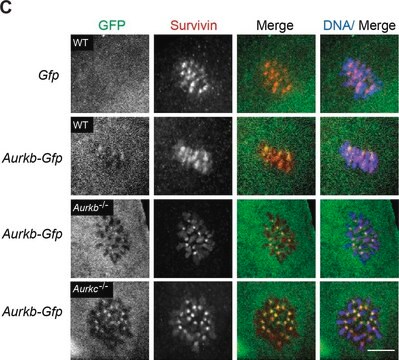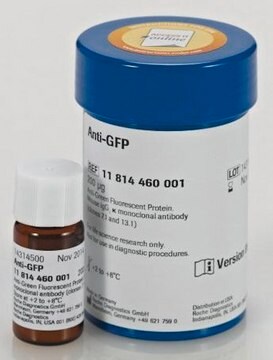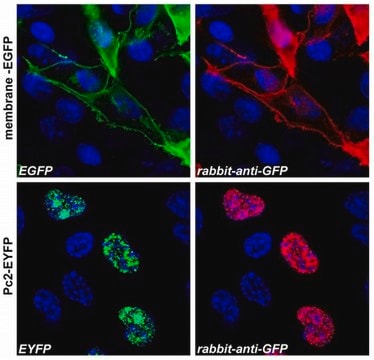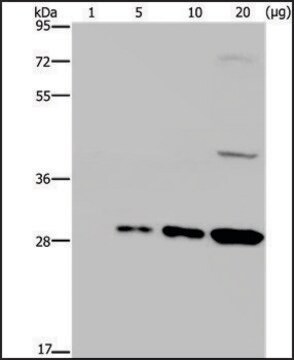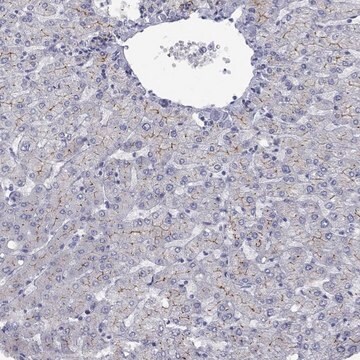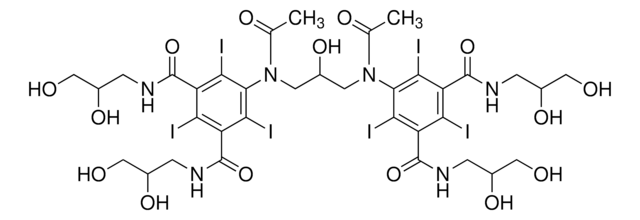MABE1906
Anti-Venus (YFP) Antibody, clone 5
clone 5
Synonim(y):
GFP(YFP), GFP(F46L)
Zaloguj sięWyświetlanie cen organizacyjnych i kontraktowych
About This Item
Kod UNSPSC:
12352203
NACRES:
NA.41
Polecane produkty
Opis ogólny
Green fluorescent protein (UniProt: P42212; also known as GFP) is encoded by the GFP gene in Aequorea victoria (Jelly Fish). GFP is a 27 kDa protein from jellyfish that serves as an energy-transfer acceptor. It transduces the blue chemiluminescence of the protein aequorin into green fluorescent light by energy transfer and it fluoresces in vivo upon receiving energy from the Ca2+-activated photoprotein aequorin. GFP has an absorption max at 395 nm and the emission peaks at 507 to 510 nm. However, the exact value of emission max depends on the environment of the chromophore. GFP has evolved into an important tool in cell biology research that displays stability under fixation conditions and is suitable for a variety of applications. Venus is a genetic mutant with F46L substitution in green fluorescent protein (GFP), derived from Aequorea victoria. Its excitation/emission peaks are 515/528 nm respectively and is often used as a donor-acceptor pair by researchers in FRET based co-localization studies. Compared to other fluorescent tags, Venus provides higher expression levels and better yields in preparative purifications. A fusion protein consisting of Venus and a defective mutant of p27 protein (p27K ) has been used to identify and isolate a population of quiescent cells and visualize the G0 to G1 transition. Clone 5 specifically detects only the Venus-tagged proteins. (Ref.: Nagai, T., et al. (2002). Nat. Biotechnol. 20(1); 87-90; Oki, T., et al. (2014). Sci. Rep. 4; Article 4012; Rana, MS., et al. (2018). Biochemistry 57(49); 6741-6751).
Specyficzność
Clone 5 is a mouse monoclonal antibody that detects proteins labeled with Venus (YFP). It does not display cross-reactivity with mCherry, mRuby, or mClover.
Immunogen
GST‐tagged full-length mVenus, a genetic mutant of GFP derived from Aequorea Victoria (Jelly fish).
Zastosowanie
Immunocytochemistry Analysis: A 1:500 dilution from a representative lot detected Venus (YFP) in NIH3T3 (L20V-9-11) cells (Courtesy of Li Ten and Kensaku Murano, Ph.D., Keio University School of Medicine, Tokyo Japan).
Western Blotting Analysis: A 1:250 dilution from a representative lot detected Venus (YFP) in HEK293T cells transfected with mVenus that was expressed using pCAGGS-Myc eukaryotic expression plasmid (Courtesy of Li Ten and Kensaku Murano, Ph.D., Keio University School of Medicine, Tokyo Japan).
Immunoprecipitation Analysis: A 1:1,000 dilution from a representative lot immunoprecipitated Venus (YFP) labeled proteins in pCAGGS-myc (negative) and pCAGGS-myc-mVenus (positive) HEK293T cell lysates (Courtesy of Li Ten and Kensaku Murano, Ph.D., Keio University School of Medicine, Tokyo Japan).
Western Blotting Analysis: A 1:250 dilution from a representative lot detected Venus (YFP) in HEK293T cells transfected with mVenus that was expressed using pCAGGS-Myc eukaryotic expression plasmid (Courtesy of Li Ten and Kensaku Murano, Ph.D., Keio University School of Medicine, Tokyo Japan).
Immunoprecipitation Analysis: A 1:1,000 dilution from a representative lot immunoprecipitated Venus (YFP) labeled proteins in pCAGGS-myc (negative) and pCAGGS-myc-mVenus (positive) HEK293T cell lysates (Courtesy of Li Ten and Kensaku Murano, Ph.D., Keio University School of Medicine, Tokyo Japan).
Jakość
Isotype testing: Identity Confirmation by Isotyping Test. Isotyping Analysis: The identity of this monoclonal antibody is confirmed by isotyping test to be mouse IgG1.
Opis wartości docelowych
~35 kDa observed; 26.88 kDa calculated for GFP. Uncharacterized bands may be observed in some lysate(s).
Postać fizyczna
Protein G purified
Purified mouse monoclonal antibody IgG1 in buffer containing 0.1 M Tris-Glycine (pH 7.4), 150 mM NaCl with 0.05% sodium azide.
Rekonstytucja
0.5 mg/mL. Please refer to guidance on suggested starting dilutions and/or titers per application and sample type.
Przechowywanie i stabilność
Stable for 1 year at +2°C to +8°C from date of receipt.
Inne uwagi
Species Reactivity Note: Aequorea victoria. Predicted to react with all species.
Oświadczenie o zrzeczeniu się odpowiedzialności
Unless otherwise stated in our catalog or other company documentation accompanying the product(s), our products are intended for research use only and are not to be used for any other purpose, which includes but is not limited to, unauthorized commercial uses, in vitro diagnostic uses, ex vivo or in vivo therapeutic uses or any type of consumption or application to humans or animals.
Ta strona może zawierać tekst przetłumaczony maszynowo.
Kod klasy składowania
12 - Non Combustible Liquids
Klasa zagrożenia wodnego (WGK)
WGK 1
Temperatura zapłonu (°F)
Not applicable
Temperatura zapłonu (°C)
Not applicable
Certyfikaty analizy (CoA)
Poszukaj Certyfikaty analizy (CoA), wpisując numer partii/serii produktów. Numery serii i partii można znaleźć na etykiecie produktu po słowach „seria” lub „partia”.
Masz już ten produkt?
Dokumenty związane z niedawno zakupionymi produktami zostały zamieszczone w Bibliotece dokumentów.
Nasz zespół naukowców ma doświadczenie we wszystkich obszarach badań, w tym w naukach przyrodniczych, materiałoznawstwie, syntezie chemicznej, chromatografii, analityce i wielu innych dziedzinach.
Skontaktuj się z zespołem ds. pomocy technicznej